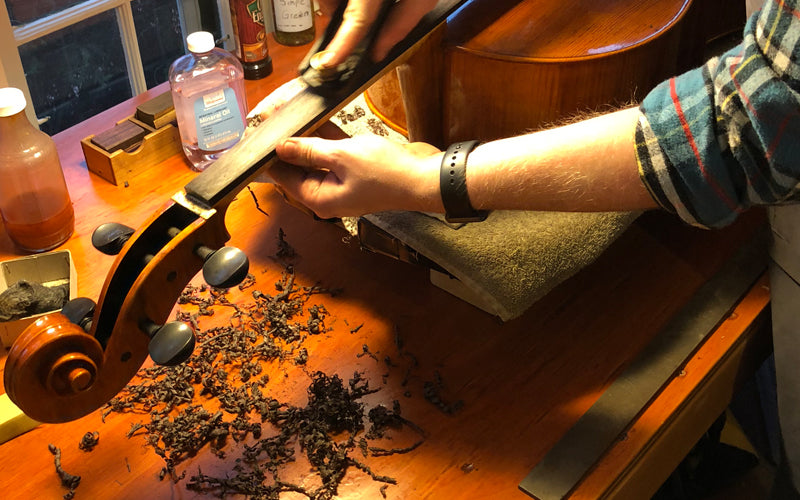Choosing the right size violin
Choosing the correct size instrument is not only an issue for children, but for adults as well, and since most children receive instruction from their string teachers or orchestra directors on sizing, we're going to concentrate this article on the neglected group — adults who might be small of stature (but mighty in personality, of course!).
Knowing what size cello or violin you need is the first step in getting an instrument that's comfortable to play — and comfort is key when it comes to mastering your craft and enjoying the experience of making music. Fortunately, whatever size you may be, there's a perfect size violin for you. Read on to discover how to measure yourself so you can get a violin or cello that suits you perfectly.
Choosing Violin Size
Many smaller adults wonder if they need to play on a 3/4 size instrument because they're unaware of the range of sizes available, or feel that full size (4/4) is too large. The range of adults who can play on a full-size violin is far greater than for viola or cello. Nearly all violinists should have little trouble playing full-size (4/4) violin. For those who have extremely short fingers, there are 7/8 size violins available. Please inquire with us or your favorite violin shop about these instruments.
Choosing Viola Size
For violas, sizes appear as a length of inches or as a fraction. Those inches represent the length of the back without considering the "bump" at the center — the button, or heel — but measuring beside it, straight down. These ranges are from 13 inches, which is the same as a 3/4 violin but is mostly reserved for children due to a drop in tonal quality, to 17", but few play such large sizes, with the majority of violists favoring 15.5" to 16.5."
For smaller adults, aim for 15" to 15.5," which is basically the equivalent to a 3/4 to 7/8 size violin, as you want to play as large an instrument as you can comfortably play, but never one too large as to harm you physically.
Choosing Cello Size
What size cello do you need? Cellists have options if they require a smaller instrument. While 3/4 size cellos are too small and often don't produce the tone desired by an adult player, there are many cellos made in 7/8 size, many of which can often sound as rich and full as a full size (4/4) cello if properly made and set up. That's extremely important for the overall performance and playability of an instrument. Check out our blog entry regarding the importance of a top-quality setup to learn more.
We at StringWorks offer a number of our cellos in 7/8 size, though we don't often keep them in stock. We have made and sold (and will have available if needed) Artist, Virtuoso, Soloist and Michael Todd cellos in 7/8 size, and invite you to inquire with us about the possibility of getting one for yourself.
Many other shops make 7/8 size models, so definitely check with your favorite violin shop or luthier if you think you might thrive on this near-full-size option. Even world-class, antique cellos in the five and six-figure price range come in 7/8 size, so your options are broad.
How to Measure Yourself to Find the Right Violin, Viola or Cello Size
The right size violin, viola or cello will improve your playing experience significantly. The first step is measuring yourself so you know which size you need. The key is measuring your arm the right way. Here's a step-by-step breakdown of how to do this:
- Sit or stand with your arm outstretched and your palm facing upward.
- Position your arm so it's perpendicular to your torso. Make sure it's somewhere between in front of you and to your side. Stretch it out in the direction you'd hold your violin or cello.
- Using a yardstick or tape measure, measure from the middle of your palm to the side of your neck.
- Read or record your measurement and compare it to the sizings below to find the right size violin or cello.
Both cello and violin sizes appear as fractions that are basically convenient titles to help you know how their sizes compare to a full-size instrument. First, let's take a look at the different cello sizes available. Below, we include cello sizes with corresponding arm lengths and heights, since your height is also crucial to your comfort when playing the cello.
Here's a guide on choosing the correct cello size:
- 1/10: Arm length under 16 inches, and height 3 feet and under.
- 1/8: Arm length, 16 to 18 inches, and height, 3 to 3.5 feet.
- 1/4: Arm length, 18 to 20 inches, and height, 3.5 to 4 feet.
- 1/2: Arm length, 20 to 22 inches, and height, 4 to 4.5 feet.
- 3/4: Arm length, 22 to 24 inches, and height, 4.5 to 5 feet.
- 4/4 (full size): Arm length, 24 or more inches, and height, 5 feet or taller.
Here's a guide on choosing the correct violin size:
Inch measurements show the arm lengths needed for a comfortable playing experience.
- 1/16: 14 to 15.5 inches.
- 1/10: 15.5 to 17 inches.
- 1/8: 15 to 17.5 inches.
- 1/4: 17.5 5 to 20 inches.
- 1/2: 20 to 21 inches.
- 3/4: 21 to 22 inches.
- 7/8: 22 to 23.5 inches.
- 4/4 (full size): 23.5 inches and longer.
Contact StringWorks Today for Answers to Your Sizing Questions
As always, feel free to call us at 888-624-6114, contact us online or visit us in-store to chat about your instrument needs or if you need help finding the right size for you. We look forward to serving you and helping you find the right size violin or cello!



